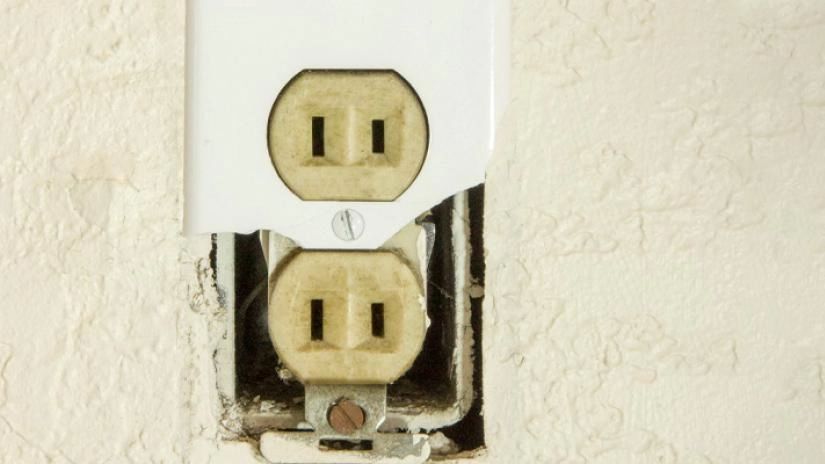
Do you have any old two-prong receptacles in your home? If so, you may be wondering "Are two-prong outlets safe?" The answer is no. They have only two wires running through them: a hot wire and a neutral wire. Two-prong outlets are not grounded, which can leave you unprotected from stray currents and result in a power surge through sensitive electronics, often destroying them in the process.
In turn, three-prong outlets feature a third grounding prong, which gives energy surges somewhere to go other than into your body or electrical equipment. This feature has been the standard for a while now, but if you live in a home built before the 1960s and you haven’t updated your outdated wiring, odds are you still have two-prong outlets throughout your home.
Are Two-Prong Outlets Safe?
Our expert video shares a quick look and covers the safety considerations around two-prong outlets and shares what you can do if you have them in your home.
Can You Keep Two-Prong Outlets?
Yes! The National Electrical Code allows you to replace an existing two-prong outlet with another one like it when no grounding wire is present in the circuit powering that outlet. This means if you must replace a faulty two-prong receptacle, you aren’t breaking any codes if you choose not to upgrade.
Where Three-Prong Outlets Are a Must
Modern, sensitive electronics come with three prongs for a reason. Anywhere you plug in computers, TVs, window air conditioners, vacuum cleaners, and other appliances or electronics with three prongs, you need a three-prong outlet. All outlets in your kitchen, for example, should be three-prong outlets.
Are There Safe Workarounds For Two-Prong Outlets?
No. Perhaps you think plugging devices into a surge protector, which you then plug into a “cheater” three-to-two prong adapter to fit the old-fashioned outlet, is the way to go. This isn’t a safe workaround. The fact remains that two-prong outlets have no ground and therefore don’t benefit from surge protectors. Note that simply swapping out two-prong outlets for three-prong versions without adding a grounding element isn’t enough, either.
Keeping Your Electronics Safe With Two-Prong Outlets (If You Must)
If you're a renter or living in an older home, and upgrading your two-prong to three-prong outlets throughout your home isn’t an option right away, there are ways to reduce risk in the meantime. Until you can have a licensed electrician upgrade your system, be smart about what you plug into your two-prong outlets.
- Avoid using cheater plugs, especially if there's no verified ground at the outlet box. These can create a false sense of safety and increase the risk of shock.
- Limit what you plug into two-prong outlets. Skip high-wattage appliances and delicate electronics like computers, TVs, or gaming consoles.
- And be cautious about extension cords or power strips—they can make overloading more likely.
Getting Your Outlets up to Code
If you're ready to stop wondering "Are two-prong outlets safe?", you have a few safe options for getting your outlets up to code.
Replace with a GFCI
If rewiring isn’t feasible, you can replace your 2-prong outlet with a GFCI (Ground Fault Circuit Interrupter) outlet. Even without a ground wire, GFCI outlets protect against electrical shock by cutting off power if they detect an imbalance in current flow. For compliance, these outlets must be labeled with a sticker that says “No Equipment Ground.” This is a common, code-approved solution in older homes.
Use existing metal conduit as ground (if available)
If your current wiring runs through metal conduit or armored cable (BX), it may already be grounded. In these cases, an electrician can test the continuity and bond the new 3-prong outlet to the metal box using a grounding clip or screw. However, this is only allowed if the metal conduit provides a continuous path back to the panel’s ground.
Install new ground wire
The most thorough and safest solution is to run a new ground wire from the outlet box back to your electrical panel or to another properly grounded outlet or junction box. This creates a true ground path. You can then replace the 2-prong outlet with a standard 3-prong grounded outlet the NEC recommends. Note that it involves accessing walls to run new wiring – a job best left to a licensed electrician.
Rewire the circuit with grounded cable
For a full upgrade, you can have an electrician rewire the entire circuit using modern, grounded electrical cable. This involves removing old two-wire cables and installing three-wire cables (hot, neutral, and ground). While this is the most expensive option, it ensures your home’s electrical system is completely up to date and future-ready.
Upgrade Safely With Mr. Electric
If you're ready to replace outdated two-prong outlets with safer, code-compliant solutions, Mr. Electric® is here to help. Our trained service professionals have the experience and tools to assess your home's wiring and recommend the best upgrade path, all backed by the Neighborly Done Right Promise® to ensure your satisfaction. With hundreds of locations across North America, we're likely right in your neighborhood. Contact Mr. Electric today to schedule a service appointment or get answers to your electrical safety questions.
This article is intended for general guidance only and is not applicable to every situation. You are responsible for determining the proper course of action for your property and situation. Mr. Electric is not responsible for any damages that occur as a result of advice and/or guidance derived from its blog content.
Some Mr. Electric services vary by location. Contact your local Mr. Electric franchise for more information.

